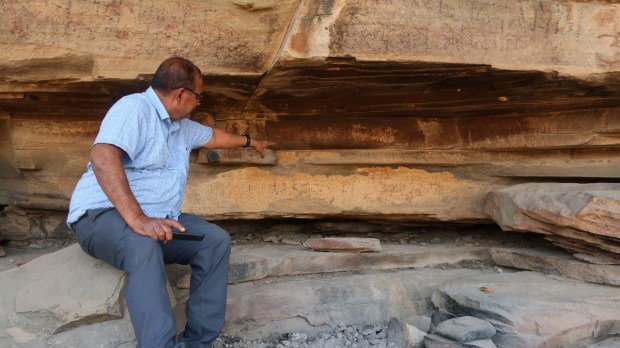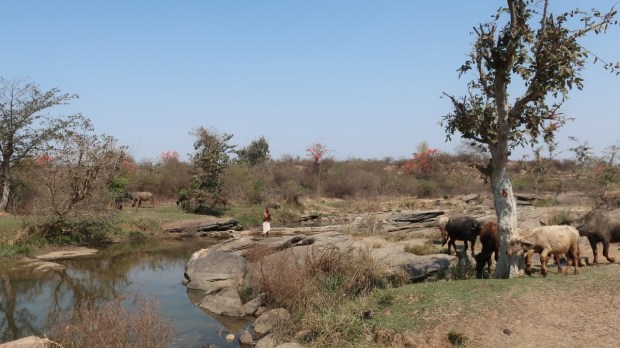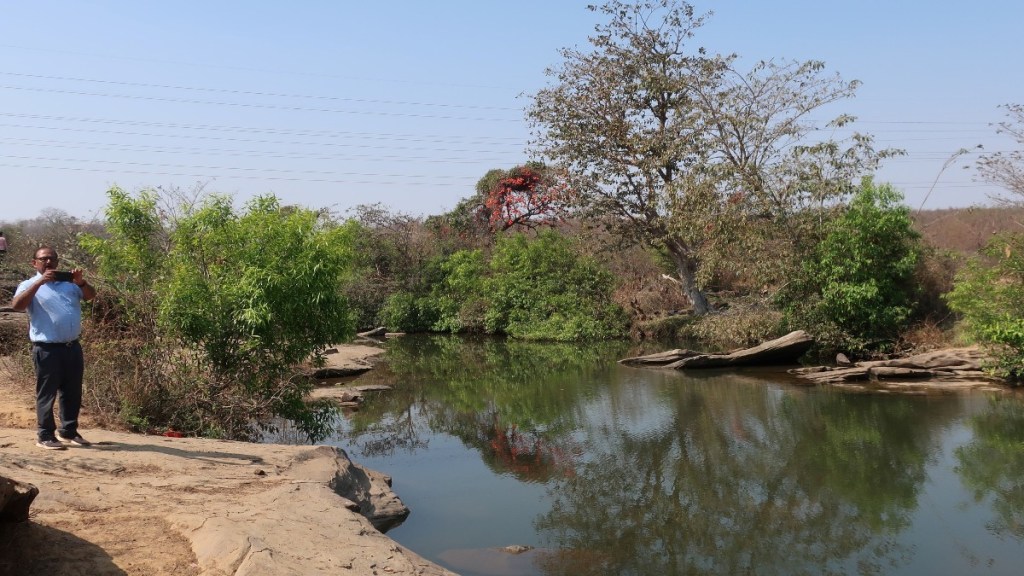Raju Mansukhani
The interview of Dr Ajay Pratap, Professor of History at Banaras Hindu University was conducted by the author, Raju Mansukhani, a researcher-writer on history and heritage issues and a former deputy curator of Pradhanmantri Sanghralaya. Here are excerpts about field surveys on prehistoric rock art in the Vindhyan ranges.
Tell us about the surveys on prehistoric rock painting you have conducted in the Vindhyan mountain ranges.
Dr Ajay Pratap: Since 2009 the faculty, students of Department of History, Banaras Hindu University have been carrying out field surveys on prehistoric rock art in the upper sandstone areas of the Vindhyan ranges. Our focus has been on Mirzapur and Sonbhadra districts of Uttar Pradesh, spread over 12,000 sq kms, and with around 1000 rock art sites. We have studied only a select sample, physically possible for us to document.
These are well-known clusters at Likhaniya Dari and Chuna Dari, Panchmukhi, Kanda Kot, ChhaanPathari, Mukkha Dari, Morhana and Lekhahia Pahar, and of course Wyndham Falls.
Most of these sites are in hilly rocky terrain, inside official forest reserves. The Vindhyan range here presents a fascinating landscape: a series of discontinuous hills, valleys and plateaus, drained by rivers like the Son, Karamnasa, Adwa and Belan and numerous streams and waterfalls.
The Vindhyas extends all the way up to the river Son, in the south, in the west up to Bhimbetka in Madhya Pradesh, and in the north up to the margins of Prayagraj. You can see on the map of India how the Vindhyas extend from southern Uttar Pradesh to Bihar, Jharkhand, Chattisgarh and Madhya Pradesh, dividing north India from the south.

When seen together with the Aravalli, Satpura and Maidal ranges, a central belt of mountains emerges on the map. Narmada river flows from Amarkantak to the west coast; the Son flowing eastwards from the same source. Just as the Narmada valley is of immense significance to early human evolution in India, the Son-Bhadra valley is of critical importance to their later development in the context of prehistoric rock art and the initial settlement of the Ganges Valley.
The Vindhyan belt owing to its elevation of about 2,000 ft. (610 m.) above mean sea level has numerous waterfalls. Wyndham, Chuna Dari, Likhaniya Dari, Mukkha Dari, Siddh Nath ki Dari, Devdari and Rajdari are some prominent sites we studied for their significant rock art clusters.
‘Dari’ means a waterfall in Persian, and along the such water sources and courses are the numerous painted rock art sporting delightful scenes and extremely important and interesting archaeological, anthropological, and historical information.
It is the affluence of this water drainage or ‘aquifers’ which sustained human life: be it the hunter-forager in the forests, or later when agro-pastoralism and full-fledged farming evolved in the prehistoric settlements up in the hills and along the valleys of these tributaries.
Koldihwa is one site in the foothills where the oldest evidence of animal and plant domestication, particularly rice (Oryza sativa indica) has been found. Agro-pastoralism refers to humans living off the land, by farming and raising cattle; there is evidence of large, traditional, cattle-pens even today in these areas. Quite clearly the cows, buffaloes, goats, and sheep would have been reared and then traded, or moved with other groups.
(As Dr Pratap explained the evolution of agro-pastoralism on site, there were cows and buffaloes coming down to the Wyndham Falls and its streams, and a villager, may have been a pujari, was performing his prayers to Mother Nature looking up to the skies and then the water flowing by. It was a timeless moment and could have been a scene going back to 8000 BCE!)
Give us an indication of time; how old are these prehistoric rock art sites?
Dr Ajay Pratap: We can go back easily to 100,000 years! You see prehistoric habitation in the valley of large rivers is dated to what is called the late Acheulean or the Lower Palaeolithic period. It was much later, roughly 30,000 to 12,000 years ago that the highlands came to be inhabited. This was the Upper Palaeolithic-Mesolithic period.
If we go back to the end of the last ice age, or the Pleistocene period, the Vindhyan regions experienced periods of heavy rainfall, alternating with high temperatures and extreme aridity.
The main Gangetic system and its tributaries are formed in this period. The vast sandstone formations, the fertile alluvial plains are a result of those times.
What have been the major studies conducted in the past?
Dr Ajay Pratap: Numerous archaeological sites have been located and excavated by the Department of Archaeology, of Banaras Hindu University and Allahabad University, in the valleys of the rivers – Damdama, Mahagara, Mahadaha, Sarai Nahar Rai, Chopani-Mando and Koldihwa.Very significant and have contributed immensely to our understanding of nature, origins of the Mesolithic, including the origins of farming in mid-Ganga plains. Owing to the rich floral cover even now in the Vindhyas, this region has rich fauna and numerous small-scale human settlements. This is truly the significance of this area: through our research, we are not only tracking the evolution of humans but also the origins of agriculture and pastoralism.
(Mesolithic refers to an interim period between the Paleolithic and the Neolithic ages: in this period, humans were living off hunting, fishing, gathering food in the forests, and later developing the competency to domesticate animals.) For lay people’s understanding, we can say it is 10,000 BCE.)
Yes, we pay our homage to AC Carlleyle, one of the first archaeologists who in 1883 discovered some paintings and stone tools at Morhana Pahar in the Vindhyan ranges. Now that is 140 years ago! Carlleyle was an assistant of the legendary Sir Alexander Cummingham who was appointed as the first Archaeological Surveyor to the Government of India. After A. C. Carlleyle, the next major survey in this region was done by James Cockburn, in the late 19th century, who located and described numerous painted shelters and associated archaeological material like stone tools and burnt bone fragments in the 19thcentury.
Senior archaeologists like RK Varma (at Bagai-Khor, Morhana Pahar), VD Misra (at Likhaniya Dari) and V.Jayaswal (at Mura hill) worked extensively in this region.J.N. Pal excavated the Mesolithic Lekhahia Pahar site on the escarpment; Vibha Tripathiexcavated an early agricultural site called Rajpura which has evidence of early iron-smelting from iron ore pellets; and Rakesh Tewari who excavated Raja Nal ka Tila in the Vindhyan highlands. Perhaps we should think of the Vindhyan regions as Central Indian Ghats rich in biodiversity, geological and cultural heritage. In our publications, reports and documentation we have synthesized the data from previous work and ours.

What about the contribution of Prof F.R. Allchin and their generation of British archaeologists?
Dr Ajay Pratap: It is immense! I had the opportunity of studying under Prof Raymond Allchin during my doctoral study at Cambridge University in the 1980s. While he studied neolithic cattle-keeping in India, particularly in South India and at Mirzapur, his wife Dr Bridget looked at the Carlleyle shelters at Morhana Pahar. She reported on the landscape, the soil profile and occurrence of differently pigmented hematite and hematite drawings. This is a storehouse of information for workers like us.
During her field surveys of 1958-59, she described the surrounding countryside, a description of the shelters, but more importantly the paintingsthemselves. She mentioned specimens of tools of the Mesolithic and Neolithic periods. Occasional iron arrow head and pottery too has been identified. This is not a surprise since the Vindhyas have the earliest pottery called ‘incised corded ware’ pottery; the use of iron datesto 1500 BCE.
At Morhana, there are at least thirteen megalithic ring-stone burials, near rock-shelters with no evidence of having been excavated. We can clearly see these were not just rock art sites but also locations with redoubtable human habitation with established social customs and norms often reflected in the paintings themselves. Surrounding rivers, streams, and forests provided enough subsistence for our ancestors.
Another challenging aspect is the topography of our entire survey area, be it at Wyndham, Likhaniya Dari, Chuna Dari and Morhana Pahar. Here the soil profile keeps changing as does the formation of the rocks: human settlements must have had a great degree of adaptability to the environment.
What were the primary goals you had set for this long-drawn out research?
Dr Ajay Pratap: In this survey-design we kept ‘documentation’ and ‘analysis’ as our primary goals. To have conservation and protection as our goals, we would require high-tech laboratories, huge funding, government permissions and legislations.
In 2009, we had developed an estimate that no proper multimedia recording, nor analysis of the types of depictions obtained chronologically in the rock art corpus of this region had previously been made. We conducted visual documentation (still photos and video recordings) of each painted shelter. Dr. Ruman Banerjee, now Assistant professor at Pondicherry University, stepped in to use the state-of-the-art Uranium-Thorium Disequilibrium Series Dating method applied to CaCo3 samples for the paintings at Wyndham Falls.
What are the challenges the prehistoric sites face?
Dr Ajay Pratap: Illegal tourism, modern graffiti, stone mining, natural processes like rain and degeneration of rocks are the challenges faced on these prehistoric sites. Rain, water-seepage within shelters, organic vegetation and fungal growth, micro-fauna like termites, spiders, wasp and bee-hives, bird-nests are all taking their toll. There is direct defacement, battering and graffiti over these ancient paintings.
Mining is rampant. Sandstone and its slabs are much in demand in Mirzapur, Varanasi as roofing material. At Wyndham Falls, we recorded one previously painted shelter now completely gutted; rock-faces with prehistoric paintings have been chiselled and carried away. We have engaged in ‘salvage archaeology’ of sorts, by trying to document as thoroughly as possible as many sites.
Our study of Vindhyan prehistoric rock art sites is not merely academic, we want to raise awareness on all academic and conservation issues involved among stakeholders, as per mandate of our funding agency – the Institution of Eminence Program of the Banaras Hindu University. We wish to involve government bodies and foreign expertise required to save this unique chapter of our ancient history.
To save millennia-old rock art of Vindhyan ranges, Dr Ajay Pratap and his team may have to spend more years ahead. More power to them!
Photo courtesy: Raju Mansukhani
The author is a researcher-writer on history and heritage issues; a former deputy curator of PradhanmantriSangrahalaya.
Disclaimer: Views expressed are personal and do not reflect the official position or policy of Financial Express Online. Reproducing this content without permission is prohibited.
